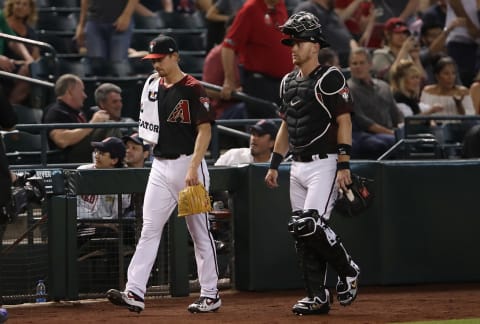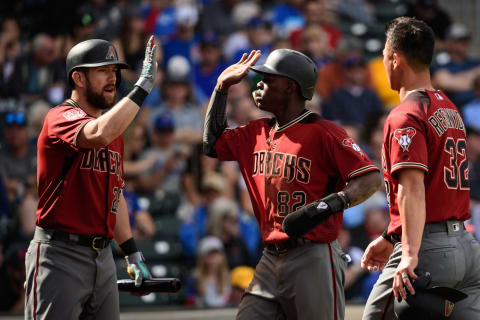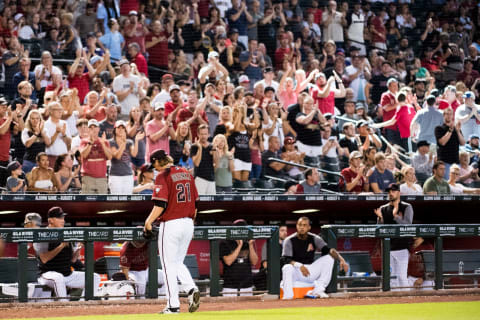Arizona Diamondbacks Front Office Doesn’t Make Trades, They Change Tires


The Paul Goldschmidt trade sparked a disconnect between Arizona Diamondbacks fans and the front office about their expectations for the 2019 season. Led by strong campaigns from Luke Weaver and Carson Kelly, the Dbacks brass has been right all along in their assessment of the 2019 team.
The Diamondbacks offseason was defined in a moment: GM Mike Hazen traded Paul Goldschmidt to the St. Louis Cardinals, returning three players and a draft pick to Arizona.
By agreeing to trade Goldschmidt to the Redbirds, Hazen effectively closed the door on a seven-year era of Diamondbacks baseball. The era spanned – you could argue – from game two of the 2011 NLDS when Goldy announced his arrival with a home run off – go figure – then-Brewer Zack Greinke; it ended when Hazen sent him the Cardinal way.
The Goldschmidt-Era Dbacks never won a division title, finishing twice in 2nd, thrice in 3rd, and once each in 4th and 5th place. They won one playoff series, technically, the 2017 Wild Card game against the Rockies, otherwise losing twice in the divisional round. Rarely do team eras wrap up so smoothly, but the Goldschmidt trade did exactly that for the Goldy/Pollock/Corbin Dbacks.
The trade also ensured the ongoing juxtaposition of the Diamondbacks’ and Cardinals’ near-and-long-term futures. The trade itself needs time to grow into its destiny: a tall and branchy Trade Tree unlikely to reach its full height until after Goldy’s Cardinals tenure is over. It is now but a sapling in the primitive stages of development.
Chapter one of this saga (let’s call it Winter 2018) presupposed the Diamondbacks as a downward trending arrow preparing to punt on the 2019 season. Fast-forward to today – just seven months removed – and already perceptions of the deal have shifted.
The supposedly star-less return unfurled not one, but two players who outproduced Goldschmidt (1.1 rWAR, 1.0 fWAR) in the first half. Luke Weaver (1.6 rWAR, 1.7 fWAR) paced the rotation before his injury, while Carson Kelly (1.4 rWAR, 1.7 fWAR) has etched his name in permanent marker atop the catcher’s depth chart.
If I were really interested in balancing the ledger and naming a trade “winner,” I would factor in the 9 combined years of team control Arizona has over Weaver and Kelly – as well as the amorphous futures of Andy Young and Dominic Fletcher (selected with the traded draft pick) – each of whom will surrender their first six years of ML service to the desert should they one day make the grade.
But at this stage, it’s downright silly to name a trade winner (say, the Diamondbacks) or a loser (say, the Cardinals).
The Diamondbacks, once painted as middle-class victims forced to take cents on the dollar for their franchise player, have magically transformed into the prescient, crackerjack diabolist who picked the Cardinals pocket without a single one of us noticing. Which begs the question: as we move close to the next round of the trading season, do we need to adjust how we think about the Diamondbacks?

What really turned the tide of public perception on this trade isn’t so much the personal performances of Weaver and Kelly or even Goldschmidt. The tide has shifted because the Diamondbacks have been decent.
At 46-45, the Diamondbacks will come out of the All-Star break just 1.5 games out of the second Wild Card spot. This qualifies as a surprise. The only certainty about the Goldschmidt deal was that it dropped the Diamondbacks from the royal rumble of contention into the nausea-inducing Count-of-Monte-Cristo dungeon currently occupied by the Giants and Marlins.
And yet here we are, the Diamondbacks off the chain and scrapping their way through the fray in their ridiculous snakeskin unis.
But you know who’s not surprised? The Diamondbacks.
While many fans spent the post-trade winter treating it like the North Star – the guiding light to illuminate the Dbacks intentions to tear this mother down, GM Mike Hazen and manager Torey Lovullo remained otherwise aligned: this team was going to compete. No matter how often and how loudly they said so, to the outside world, the team’s direction was clear (thumbs-down fart sound).
But the Diamondbacks’ brass were unwavering in their confidence. And it was soooo cute. Still, it was all too easy – natural, even – to presume Hazen/Lovullo were being….maybe coy? maybe diplomatic? But definitely disingenuous when they denied the (obvious) rebuild underfoot.
After all, why would they think the Diamondbacks could sniff contention after departing Goldy, A.J. Pollock and Patrick Corbin? Hazen’s faith was beyond incongruous with public evaluations of the talent on-hand: it was antithetical.
Only the Diamondbacks never wanted to rebuild. “We knew this would be a year where we could go one way or the other,” team President & CEO Derrick Hall recently told The Athletic’s Zach Buchanan. “I don’t know that we’ve defined which way we should go at this point.”
The Goldschmidt trade wasn’t a coda for a Diamondbacks era of contention – it was the prologue to an era of pit-crew roster building. Hazen’s gonna fix this team on the fly.

For those of you still holding out hope that the Diamondbacks will scrap this project and embark on a stripped-down-to-the-studs-style rebuild, Hall has some thoughts on that too:
“Baseball has shown that, in general, these rebuilds are maybe worth going through and they’re much more tolerated today than they have been in the past. I would agree with Mike, though. Internally, we would try to avoid that as much as possible.”
To steal a phrase: ay, there’s the rub! The Diamondbacks – like the Cardinals – aren’t going to rebuild. Not now and maybe not ever.
It’s easy to look at the Diamondbacks roster and see a more dazzling future after a rebuild. Their next great core is set up to align with the development of top prospect Jazz Chisholm, who’s only 21-years-old, ticketed by MLB.com for a 2022 arrival in the bigs. The boilerplate wisdom of the day says they should maximize that era by acquiring more pieces on a similar timeline – as they did this winter with their absolute haul of a draft class.
It just so happens that most of the Diamondbacks best prospects – at least offensively – are already on a similar developmental timetable: Blaze Alexander, Alek Thomas, Kristian Robinson, Geraldo Perdomo are all predicted to arrive in the majors around the same time as Chisholm. At least some of their 2019 draft class will have chance to join this track as well.
A rising talent core is ideal for an organization’s development in part because young stars are able to rise through the ranks together, learning to win together, learning to lose together, building bonds that will translate to a pressurized and spotlit major league clubhouse.
But by aggressively promoting Chisholm to Double-A this year, the Dbacks chose to bypass even this benefit of a structured rebuild.
Perhaps because they are never going to rebuild. Not in the teardown, recurring top-5 draft pick way that works so well in OOTP and The Show.
The platonic roster build might very well involve taking the plunge, cultivating a prospect core and letting them rise or fall together until the organization is ready for a collective exhale of talent to the major league level.
But Plato’s cave clearly wasn’t in a mid-market. Tracking Arizona’s decision-making by the on-field talent is akin to chasing shadows. The games themselves offer only a reflection of the factors that truly motivates the Diamondbacks’ decision-makers.

The real act of sorcery here wasn’t cast by the Arizona Diamondbacks or the Cardinals or Mike Hazen or Paul Goldschmidt, but by the Arizona fanbase.
Said Hall on the chances of buying or selling this season:
“I think a lot of people were waiting to see what would happen with this team. That happens every year. Our market, for the most part, is a wait-and-see. If we’re playing well and we’re giving them a reason to come out, they will when school is back in or when summer’s over. We always see a push in August and September if the team is doing well and in contention. That’ll be the same now.”
Whether by apathy or cunning, the Arizona fanbase has strong-armed the front office into annual accountability. This isn’t a one-year aberration: Hall flat-out states that the August-September attendance cycle dictates trading season on an annual basis for the Diamondbacks.
Even as fans spit on the team’s chances for contention all winter, Hazen, Lovullo and company knew the Snakes could hold the line because they had faith in their ability to churn at least four months of competitive baseball. At 46-45, they are a fortnight away from avoiding a low-scale sell-off.
It’s not an easy stretch of baseball (save for three against the Orioles), but the Diamondbacks may even find themselves buying another pitcher or two before July is out. If they stay close, Hazen and company will do their best to keep this team in the hunt – because that’s what fans in Arizona will pay to see, god love ’em.
It all starts on Friday with three games against – who else – the Cardinals. Then one final loop around the track before Hazen will have take his shot to swap out the tires (is that what pit crews do?) before sending this Diamondbacks team back onto the track for the final laps.
If all goes according to plan – and it has thus far – the Diamondbacks will be playing games of consequence through August and into September – and fans in Arizona will be there to put their hearts (and dollars) on the line once again.
Next. Who Is The NL MVP?. dark
Of course, the Arizona Diamondbacks aren’t really all that likely to make the playoffs or survive a one-game playoff if they make the wild card, let alone get past the Dodgers in the NLDS.
When their season ends in September, fans will trudge home en masse to lament the hopelessness of Arizona baseball. Hazen and Lovullo, meanwhile, will go about the process of proving once again that they have a contender worth seeing in the desert.